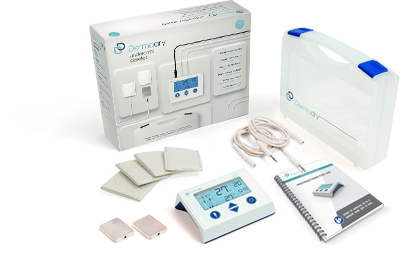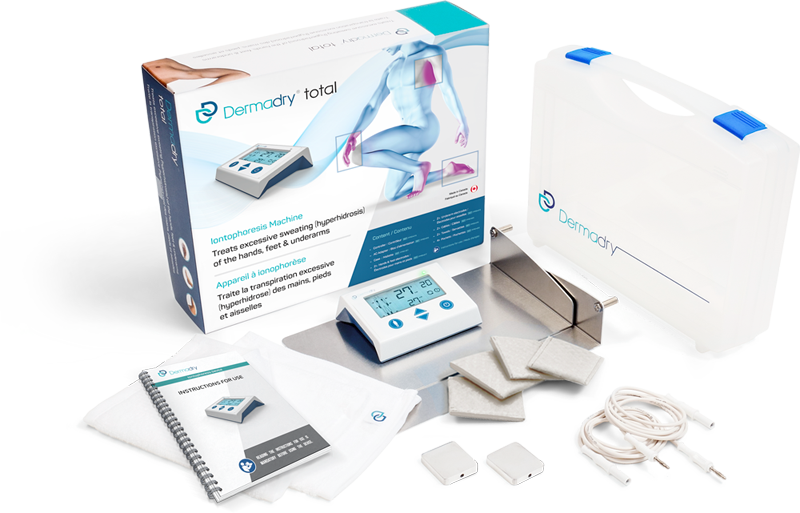What is secondary hyperhidrosis?
Dermadry Team
There are two main types of hyperhidrosis, differentiated by the cause of the sweating and the areas affected. These are called primary hyperhidrosis and secondary hyperhidrosis.
What is the difference between primary hyperhidrosis and secondary hyperhidrosis?
Primary = of primary origin (unknown cause).
Secondary = secondary to another medical condition, or side-effect of a medication.
Primary Hyperhidrosis
Excessive sweating can happen, well, without a reason! Primary hyperhidrosis is a chronic condition of unknown cause.
Those with primary hyperhidrosis can sweat anytime, anywhere, in any temperature, and up to 4-5x more than the average person or what is needed for body temperature regulation.
It is believed to be caused by an overactive sympathetic nervous system, and hereditary. Primary hyperhidrosis is of primary origin, meaning it is not a side-effect or secondary to another underlying condition.
Primary hyperhidrosis typically affects certain areas of the body, most commonly the hands, feet, underarms, and head. Those with hyperhidrosis will generally start experiencing symptoms in childhood to adolescence, particularly with the onset of puberty. In nearly all cases, symptoms (excessive sweating) will appear before the age of 25.
Secondary Hyperhidrosis
Excessive sweating can be the result of an underlying medical condition or can be a side effect of a medication. If that is the case, then it is referred to as secondary hyperhidrosis, as it is secondary to another (primary) condition or a secondary effect to a medication.
Secondary hyperhidrosis is typically generalized, meaning it affects the entire body and is not localized to certain body parts, as is the case with primary hyperhidrosis.
Essentially, if a cause is identified, then it is secondary hyperhidrosis, as there is no known cause for primary hyperhidrosis.
What medical conditions can cause excessive sweating?
There are a wide array of reasons you may be experiencing severe sweating. Some common causes include:
- - Infections
- - Cardiovascular Health Problems
- - Alcoholism
- - Obesity
- - Thyroid Problems
- - Menopause
- - Diabetes
- - Nervous System Disorders
- - Low Blood Sugar
There are a lot of things that can cause excessive sweating. If you’ve noticed a sudden onset of excessive sweating, and especially if you are experiencing any other symptoms, then it’s best to make an appointment with your doctor
What medications can cause excessive sweating?
Some common medications that can cause excessive sweating include:
- Psychiatric Medications (antidepressants, antipsychotics, etc.)
- Migraine Medications
- Pain Relievers
- Opioids
- Hormonal Medication (birth control pills, thyroid medications, testosterone and estrogen pills, insulin, cancer therapy, etc.)
- Topical Skin Medications (steroid creams, acne medication, etc.)
Withdrawal from certain types of drugs and medications can cause excessive sweating. Even non-prescription medications containing acetaminophen/paracetamol and ibuprofen can cause excessive sweating in some people.
For a more complete list of medications known to cause excessive sweating, check out the International Hyperhidrosis society’s list here.
How to treat secondary hyperhidrosis?
If you’ve experienced sudden onset sweating, the best course of treatment is to consult a medical professional to identify and treat the underlying condition or identify the medication causing excessive sweating.
If you’ve started sweating excessively after starting a new medication, check to see if excessive sweating is a side-effect of your medication, and speak to your healthcare professional about this side-effect you are experiencing and if anything can be done about it.
If you’re given the clear, and your secondary hyperhidrosis is being caused by something that cannot be changed (e.g. you cannot stop your new medication), or is something you’re experiencing as a result of hormones (e.g. menopause), then the course of treatment will be similar to that of primary hyperhidrosis. Depending on where you are sweating from, different treatments are available to you, including antiperspirants, iontophoresis, botox injections, and prescription medications. Learn more about treating hyperhidrosis in our hyperhidrosis treatment guide.
If you’re one of the millions of people struggling with excessive sweating in your hands, feet and/or underarms, then iontophoresis may be a good treatment option for you. Are you new to it? Well, for starters, it’s much harder to pronounce than it is to use! Discover at-home iontophoresis treatment by browsing Dermadry’s range of targeted medical devices below.























